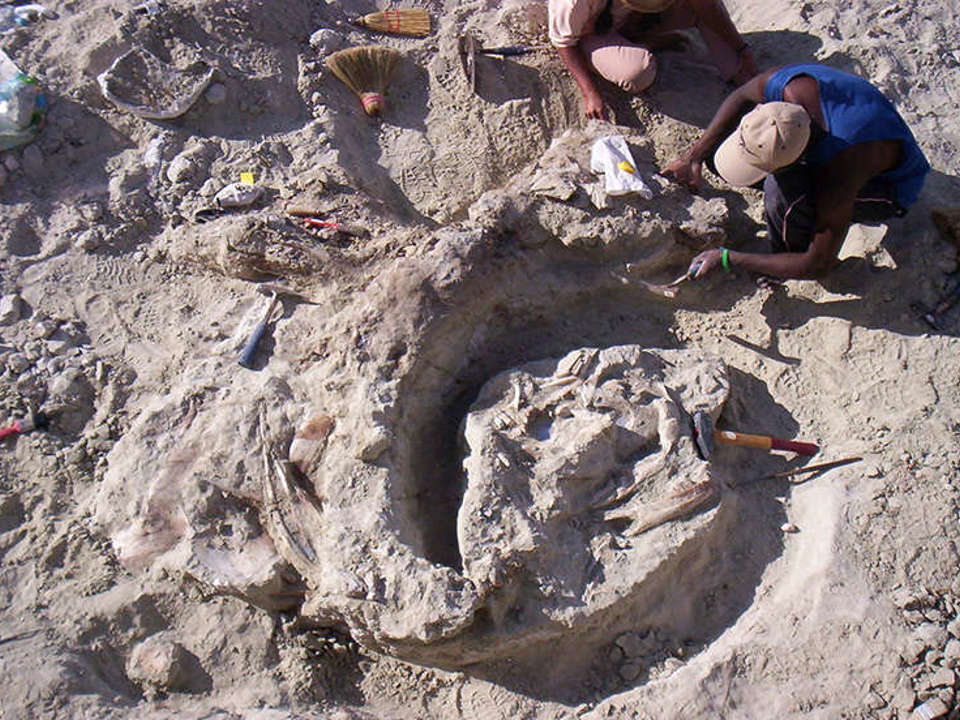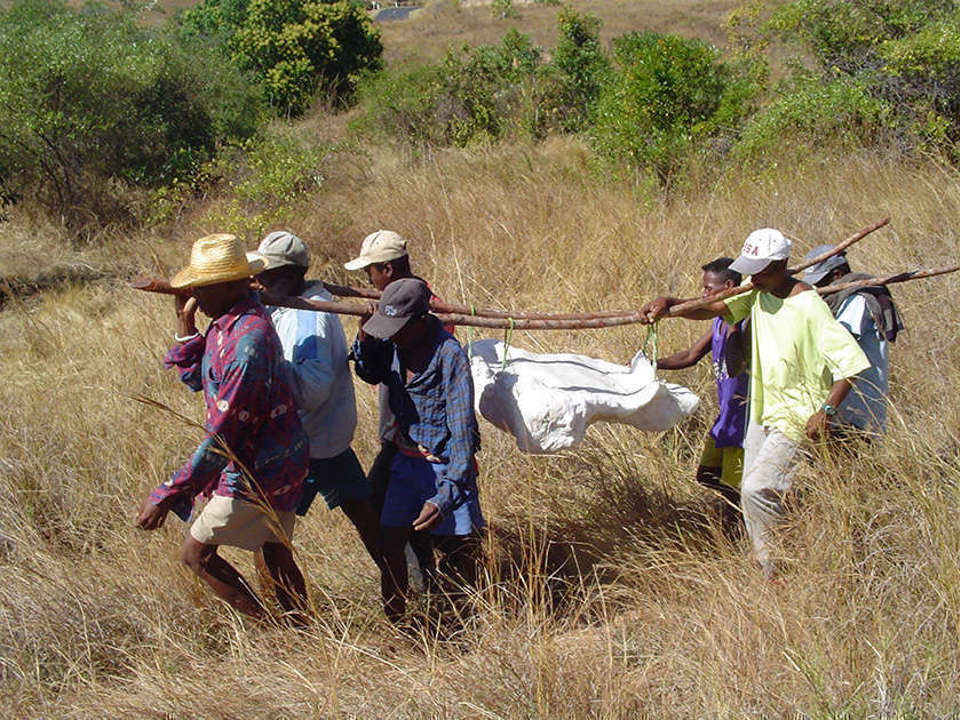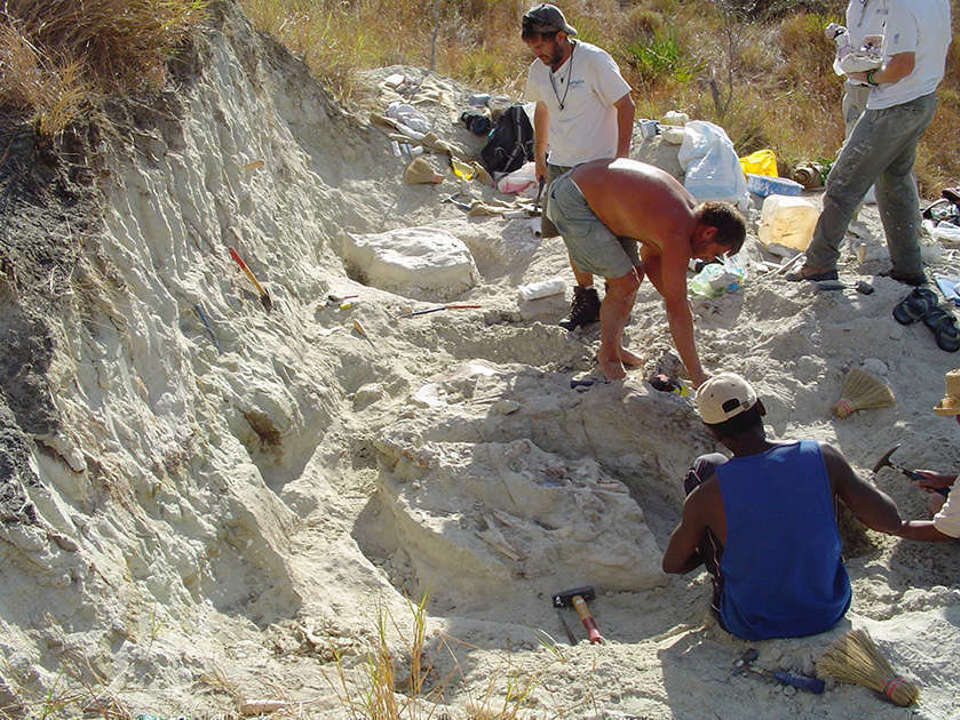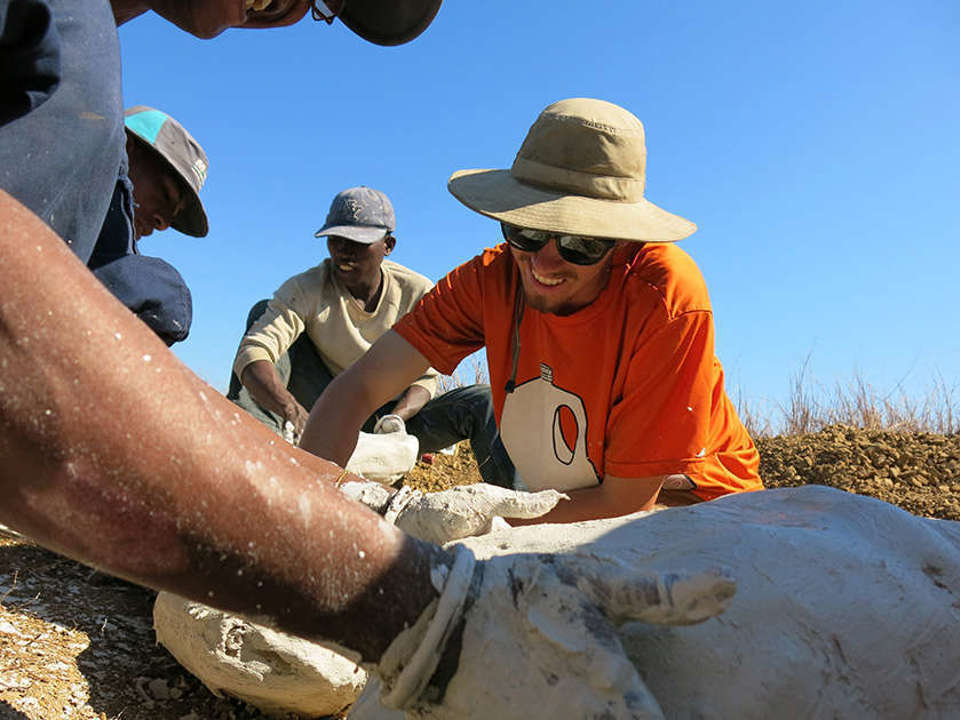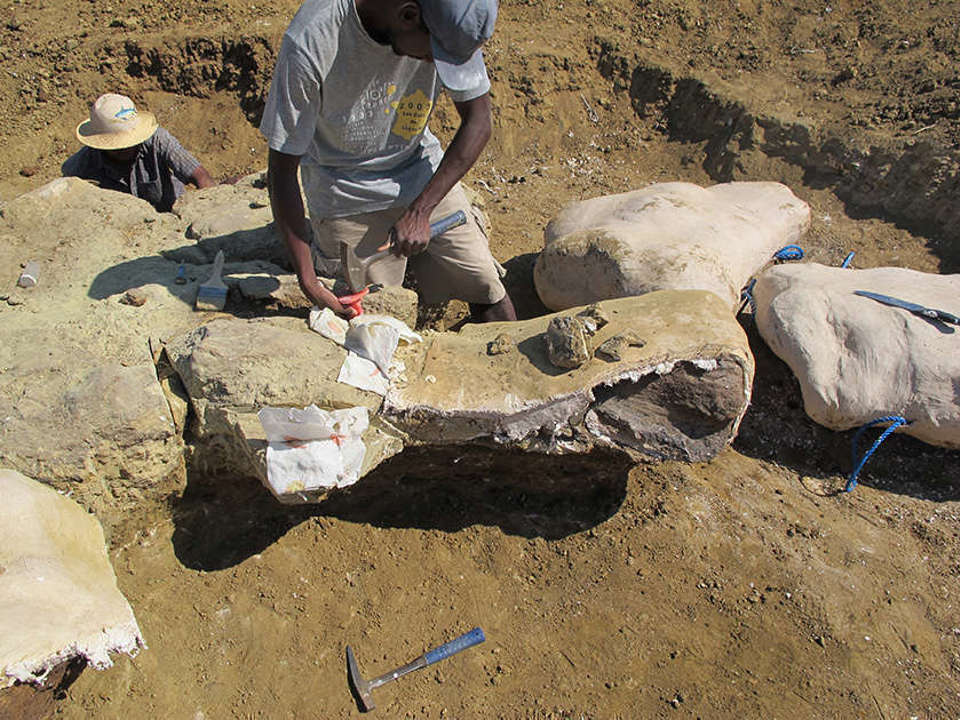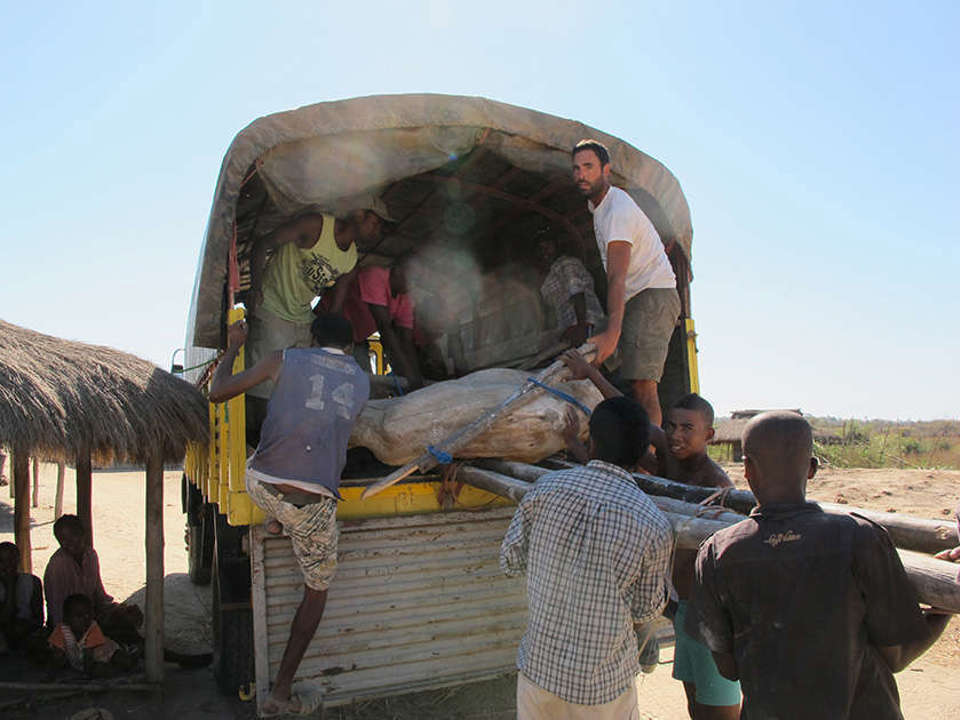The Madagascar Paleontology Project is focused on vertebrate fossils from the Cretaceous of the Mahajanga Basin but also includes efforts in the Morondava and Ambilobe basins
The Madagascar Paleontology Project (MPP), initiated in 1993, is designed to elucidate the biogeographic and plate tectonic history of the southern supercontinent of Gondwana in general and the island of Madagascar in particular. Our paleontological discoveries in the Mahajanga Basin of northwestern Madagascar during the course of 13 highly successful expeditions as well as recent expansion into the Ambilobe Basin in northernmost Madagascar and the Morondava Basin in western Madagascar have established the island as having some of the most complete and scientifically significant specimens of Cretaceous vertebrate animals from all of Gondwana and, indeed, the world. The discoveries in the Mahajanga Basin, most of them from a small area in the Maevarano Formation near the village of Berivotra, have more than quintupled the previously known diversity of Late Cretaceous vertebrates from Madagascar and now include specimens of fishes, frogs, turtles, lizards, snakes, crocodyliforms, pterosaurs, non-avian dinosaurs, birds, and mammals. Many of the specimens recovered represent animals that are new to science––we have named and described 20 new taxa––and include complete skulls and skeletons that are the most complete for entire clades.
Learn More
Approximately 180 million years ago, the southern supercontinent of Gondwana began to fragment into isolated landmasses, with dramatic consequences for the associated terrestrial and freshwater vertebrate faunas. Reconstructions of the timing and sequence of this fragmentation are based almost entirely on geophysical/paleogeographical evidence and remain poorly tested paleontologically. Madagascar is of unusually high paleobiogeographic interest and intrigue because:
- It occupied a central geographic position within Gondwana and was among the first (western margin) and last (eastern margin) landmasses to be involved in fragmentation of the supercontinent;
- It has been isolated from all other Gondwanan landmasses for over 85 million years;
- The timing of its separation from other major Gondwanan landmasses, particularly Antarctica but also the Indian subcontinent, has been controversial;
- It has a highly endemic and unbalanced modern biota whose biogeographic origins mostly remain a mystery because Madagascar's pre-Late Pleistocene Cenozoic fossil record is virtually nonexistent; and
- Its Cretaceous fossil record of vertebrates is spotty and largely confined to a single time horizon in one small field area of northwestern Madagascar (but which continues to be highly productive).
This project was initiated in 1993 by David Krause (at Stony Brook University until 2016) and is now led jointly by paleontologists/geologists from the Denver Museum of Nature & Science (David Krause, Joseph Sertich), Ohio University (Patrick O’Connor), Macalester College (Kristina Curry Rogers and Raymond Rogers), and Stony Brook University (Alan Turner). It is conducted in collaboration with the Faculty of Science, University of Antananarivo, with permissions from various ministries (Higher Education, Mines, Culture) of the Republic of Madagascar and with substantial contributions from many other research colleagues and students around the world. It has served as a strong training ground for students from both Madagascar and the United States.
The project continues to have as its major broad objectives:
- To discover and collect terrestrial and freshwater vertebrates from Cretaceous strata of Madagascar, with a strong emphasis placed on sampling the entire vertebrate fauna by employing surface prospecting, quarrying, and screening methods from as many areas and horizons as logistically and temporally feasible as possible;
- To describe the vertebrate fauna from the Cretaceous of Madagascar, to conduct rigorous phylogenetic analyses of the taxa discovered and the clades they represent, and to employ those analyses in tests of competing biogeographic and plate tectonic hypotheses related to the fragmentation of Gondwana in general and the isolation of Madagascar in particular;
- To elucidate the paleobiology of those vertebrate taxa represented in the Late Cretaceous of Madagascar by relatively complete and well-preserved remains through comparative analysis and ecological/functional inferences;
- To document the litho-, bio-, and magnetostratigraphy, sedimentology, and taphonomy of Cretaceous horizons in the Mahajanga Basin in particular but also the Morondava and Ambilobe basins; and
- To expand explorations for fossil vertebrates to both older and younger horizons in the Mahajanga, Morondava, and Ambilobe basins in our quest to elucidate the biogeographic and plate tectonic history of the island of Madagascar in particular and of Gondwana in general.
Thirteen expeditions (1993, 1995, 1996, 1998, 1999, 2001, 2003, 2005, 2007, 2010, 2011, 2012, 2015) have been conducted to date, resulting in a quintupling of the previously known species diversity of Late Cretaceous vertebrates from Madagascar. Our work has been concentrated in Upper Cretaceous strata of the Mahajanga Basin of northwestern Madagascar but has expanded to also include efforts in the Ambilobe Basin to the north and the Morondava Basin to the south.
The MPP has been funded by grants from the US National Science Foundation (DEB-9224396, EAR-9418816, EAR-9706302, EAR-0106477, EAR-0446488, EAR-0940759, DEB-1011302, EAR-1123642, EAR-1528273, 1664432), the National Geographic Society (1999–2000, 2001–2003, 2004–2005, 2009–2010, 2012–2013), the Dinosaur Society (1995), and the Simons Foundation (2007–2008).
Mahajanga Basin
The Mahajanga Basin Project (MBP), initiated in 1993, is centered in the large depositional basin located in northwestern Madagascar. We have focused on the Maevarano Formation and developed four major study areas named Berivotra, Lac Kinkony, Masiakakoho, and Befandrama. The most fossiliferous, by far, is the Berivotra Study Area, from which we have recovered approximately 20,000 specimens and 50 taxa of fishes, frogs, turtles, lizards, snakes, crocodyliforms, pterosaurs, non-avian dinosaurs, birds, and mammals. Many of the specimens are articulated and complete, with excellent preservation, occasionally including not just bones and teeth but relatively soft tissues such as keratin and cartilage. Many of the specimens reveal unusual and even unique anatomical structures, likely the result of evolution in isolation, since Madagascar has been an island isolated in the Indian Ocean for ~88 million years. Most of the specimens have been recovered from the Anembalemba Member, but important additions to the Late Cretaceous fauna of Madagascar have been made from the Lac Kinkony, Masorobe, and Miadana members as well. A strong effort has been made to employ a variety of collecting methods—surface prospecting, quarrying, screening (both wet and dry)—in an attempt to sample the entire vertebrate fauna.
Morondava and Diego Basins
The exquisitely preserved and diverse vertebrates of the latest Cretaceous Maevarano Formation of northwestern Madagascar have instigated numerous hypotheses regarding the timing and sequence of the breakup of the supercontinent of Gondwana. However, a gap of more than 20 million years between Madagascar’s isolation as an island landmass (~90 mya) and the well-known vertebrate faunas of the Maevarano Formation (~66 mya) leave many of these hypotheses difficult to test. Reconnaissance of other “middle” and Upper Cretaceous locations across Madagascar have provided promising results, including the recovery of dinosaur remains from the Diego Basin of northernmost Madagascar and from the Morondava Basin of western Madagascar.
An international team of scientists led by David Krause, senior curator of vertebrate paleontology, have discovered a new fossil mammal, Adalatherium hui, from the island of Madagascar. First published in the prestigious scientific journal Nature, this new mammal is represented by an articulated and well-preserved skeleton, the most complete for any mammal from the entire Mesozoic of the southern hemisphere. Adalatherium, which literally means "crazy beast," belongs to a lesser known group of mammals called gondwanatherians that previously were represented by only a single skull and isolated jaws and teeth. The skeleton has many features that are uniquely bizarre, consistent with a history of isolation on the island of Madagascar for over 20 million years.
Madagascar Ankizy Fund
Madagascar is one of the very poorest countries in the world. In the course of paleontological fieldwork, our interactions with the children (“ankizy” in the Malagasy language) living in remote areas demonstrated a great need for both education and health care. There are no schools in many of these areas, and the vast majority of children have never been seen by a doctor or dentist. Many times, children whom we have gotten to know quite well suffer and die from easily treatable illnesses and are not there when we return on the next expedition. We felt we could help.
In 1998, we formed the Madagascar Ankizy Fund (MAF); its mission is to provide education and health care for these children. Four primary schools have been built, a system whereby students can receive secondary education in city schools has been established, an orphanage has been renovated, many wells have been dug, water filters and mosquito nets have been distributed, health care teams from Stony Brook University (SBU) have conducted several medical and dental missions, sister-institution status between SBU’s School of Dental Medicine and the only dental school in Madagascar has been established, and a program through which used and surplus hospital equipment and supplies are shipped from hospitals on Long Island to those in Madagascar has been initiated.
MAF is administered through the Stony Brook Foundation, a 501(c)(3) not-for-profit education corporation.
For more information on the Madagascar Ankizy Fund, please visit www.ankizy.org.

